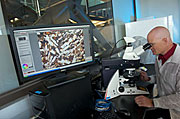- Number 344 |
- August 22, 2011
Industrial-scale carbon storage runs to ground

McLing examines a thin section
of thoelitic basalt to determine
its exact elemental mineral
composition and surmise its
reactive properties.
Understanding how carbon dioxide can be stored underground is crucial for the progression of industrial-scale carbon sequestration. Such research is thriving internationally, and the role of DOE's Idaho National Laboratory in the carbon sequestration arena is growing both domestically and abroad.
For example, INL researchers helped organize a recent International Energy Agency (IEA) Greenhouse Gas R&D Program conference focused on natural CO2 storage systems. Conference presentations focused on a range of topics including challenges of monitoring CO2 leakage from natural systems, and how CO2 releases affect groundwater, flora and fauna. The group's final report, released this spring, outlines research findings and areas needing more investigation.
Efforts to better understand natural storage systems are key parts of INL's research, which includes studying natural CO2 discharge at Idaho's Soda Springs. Travis McLing, a conference steering committee member and researcher with the Center for Advanced Energy Studies at INL, leads a team studying chemical species that fluctuate with CO2 levels. Distinctive chemical signatures that indicate when water has been in contact with underground CO2 can spotlight CO2 leaks and help fine-tune laboratory setups to better reflect real-world conditions.
Lab experiments that accurately mimic natural systems will do a better job of answering new questions that can't yet be tested in the field. Such work also helps the research community learn how and why CO2 becomes trapped or escapes from geologic formations.
Such work is helping guide pilot projects, including two in the Northwest that are among the largest carbon storage demonstrations in the nation. A site in eastern Washington will be the first in the U.S. to test whether a certain type of basalt can store 1,000 tons of CO2 for three years. A second site in Montana will receive 1 million tons per year for three years.
Both projects are led by the Big Sky Carbon Sequestration Partnership — a collaboration among universities, national labs, private companies and state agencies. Their work aims to demonstrate the safety and viability of large-scale carbon storage.
"We need to understand the spectrum of behavior so we can embark on industrial-scale demonstrations with some knowledge," said McLing. "We're trying to form a community to provide the justification to move forward, but we've only been studying CO2 for about a decade, so the field is pretty young."[Nicole Stricker, 208.526.5955,
nicole.stricker@inl.gov]
